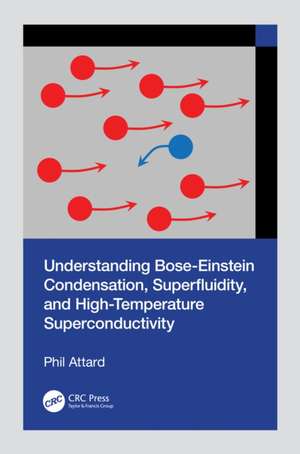Understanding Bose-Einstein Condensation, Superfluidity, and High Temperature Superconductivity
Autor Phil Attarden Limba Engleză Hardback – 2 ian 2025
This book presents these phenomena in terms of particles, their positions, and their momenta, giving a concrete visualisation and description that is not possible with traditional wave functions. A single approach that bridges the classical-quantum divide provides new insight into the role of particle interactions in condensation, the nature of collisions in superfluid flow, and the physical form of Cooper pairs in high-temperature superconductors.
High-temperature superconductivity is explored with quantum statistical mechanics, which links it to Bose-Einstein condensation. Identifying a new mechanism for Cooper pairing, this explains the differences between the low- and high-temperature superconducting regimes and the role of the molecular structure of the conductor.
The new perspective offered by this book on Bose-Einstein condensation, superfluidity, and high-temperature superconductivity gives particle-based explanations as well as mathematical and computational methods for these macroscopic quantum phenomena so that readers understand the role of particle interactions and structure in the physics of these phenomena.
This book will appeal to undergraduate and graduate students, lecturers, academics, and scientific researchers in the fields of Bose-Einstein condensation and condensates, superfluidity, and superconductivity. It will also be of interest to those working with thermodynamics, statistical mechanics, statistical physics, quantum mechanics, molecular dynamics, materials science, condensed matter physics, and theoretical chemistry.
Key Features:
· Explores Bose-Einstein condensation with new evidence for multiple condensed states and novel Monte Carlo simulations for interacting bosons
· Establishes the thermodynamic nature of condensed bosons from an analysis of fountain pressure measurements, including that they carry energy and entropy, and the thermodynamic principle of superfluid flow
· Derives equations of motion for condensed bosons, and performs molecular dynamics simulations of the viscosity with molecular trajectories that give rise to superfluidity
· Identifies the mechanism for electron pairing in high-temperature superconductivity
Preț: 732.45 lei
Preț vechi: 893.22 lei
-18% Nou
Puncte Express: 1099
Preț estimativ în valută:
140.17€ • 144.81$ • 116.66£
140.17€ • 144.81$ • 116.66£
Carte tipărită la comandă
Livrare economică 26 martie-09 aprilie
Preluare comenzi: 021 569.72.76
Specificații
ISBN-13: 9781032823935
ISBN-10: 1032823933
Pagini: 296
Ilustrații: 120
Dimensiuni: 156 x 234 mm
Greutate: 0.58 kg
Ediția:1
Editura: CRC Press
Colecția CRC Press
Locul publicării:Boca Raton, United States
ISBN-10: 1032823933
Pagini: 296
Ilustrații: 120
Dimensiuni: 156 x 234 mm
Greutate: 0.58 kg
Ediția:1
Editura: CRC Press
Colecția CRC Press
Locul publicării:Boca Raton, United States
Public țintă
Postgraduate and Professional ReferenceCuprins
Chapter 1: Introduction. Chapter 2: Ideal Boson Model of Condensation. Chapter 3: Interacting Bosons and the Condensation Transition. Chapter 4: Fountain Pressure and Superfluid Flow. Chapter 5: Molecular Dynamics of Superfluidity. Chapter 6: High-Temperature Superfluidity. Chapter 7: Quantum Statistical Mechanics. References. Index.
Notă biografică
Dr Phil Attard is an independent research scientist working broadly in classical and quantum statistical mechanics, equilibrium and non-equilibrium thermodynamics, and colloid science. He was a Professorial Research Fellow of the Australian Research Council and has authored some 150 papers with over 7000 citations. He has contributed measurement techniques for atomic force microscopy, computer simulation and integral equation algorithms for condensed matter, the second entropy principle for non-equilibrium thermodynamics, the classical phase space formulation of quantum statistical mechanics, and nanobubbles.
Descriere
This book presents these phenomena in terms of particles, their positions, and their momenta, giving a concrete visualisation and description that is not possible with traditional wave functions.
